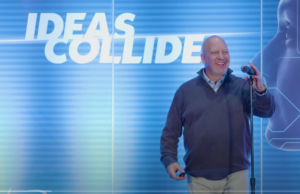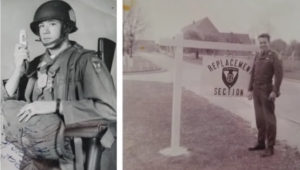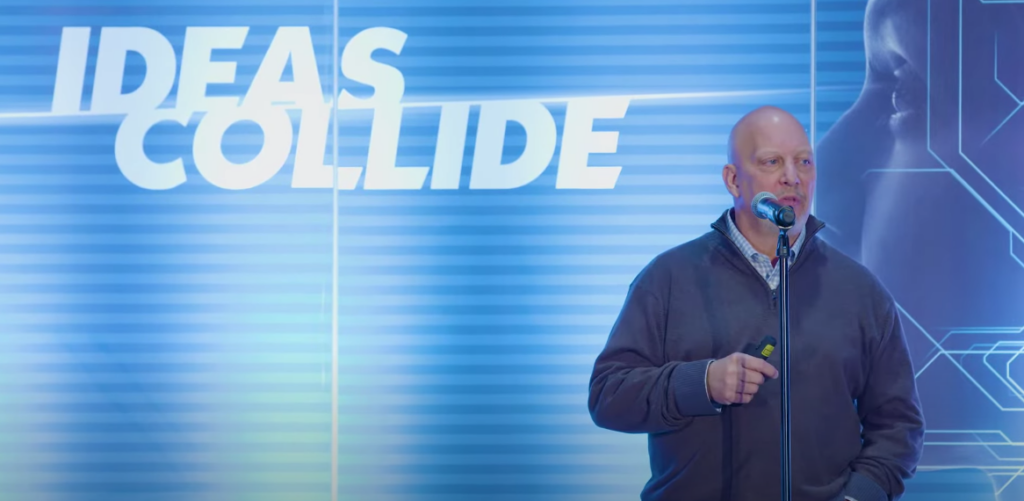
IDEAS Collide: Repairers have a ‘moral and ethical’ obligation to follow OEM procedures
By onBusiness Practices | Collision Repair
The Society of Collision Repair Specialists (SCRS) has posted its final IDEAS Collide video from last year’s Specialty Equipment Market Association (SEMA) show, featuring Collision Advice CEO Mike Anderson.
Anderson got personal when imploring the audience to make safety inspections a “non-negotiable” item. He shared one story about how a safety oversight changed his father’s life, and another about how a medical error ended it.
Anderson detailed how his father Albert served in the U.S. Military during the Vietnam War and suffered permanent injuries when he jumped from a helicopter while wearing a defective parachute. 
The fall broke both his back and both his legs, forcing him to spend two years recovering in a hospital, Anderson said.
“My dad got out of the military as a disabled vet,” he said. “My dad could never run and play ball with me as a kid. My dad could never swim. My dad could never snow ski.”
His dad endured long-term leg issues as a result of the accident and last May was hospitalized because of his leg injuries. Anderson said another mistake, this time at the hands of a medical team that failed to follow protocol, cost his father his life.
“When they did the process they didn’t sew him back up properly,” Anderson said. “He ended up bleeding internally and they didn’t discover it until after he had a massive heart attack three days later.”
Anderson then pivoted the conversation to collision repair, and used his father’s tragic circumstances to underscore the importance of following proper OEM procedures when working on vehicles.
He explained how every OEM has a document that details what inspections are required following an accident. This includes inspecting seatbelts, removing and inspecting the steering column, and more.

Anderson said that even if repairers find no issues in the majority of their inspections, it’s the times when they do find issues that matter.
Improperly repaired vehicles have had life-altering effects in a number of cases.
He referenced the John Eagle Collision Center case, which panel-bonded a replacement roof to a 2010 Honda Fit rather than using the welds dictated by Honda OEM repair procedures.
The 2010 Honda Fit, occupied by Matthew and Marcia Seebachan, was later involved in a collision on a 75 mph stretch of road when a 2010 Toyota Tundra in the other lane hydroplaned into their vehicle, leading to the Fit striking the right front quarter of the Tundra. As a result of the improperly bonded hood, the couple became trapped in the Fit as it burned.
Marcia said the collision tore the tendons between her spine and skull — and had the crash occurred two years prior, she would have been paralyzed given the state of medical science. Both she and her husband had damage to their carotid arteries, and her pelvis was shattered.
Separately, a recently-settled lawsuit blamed an improperly installed steering rack for causing a collision that injured a 27-year-old man. The driver claimed had brought his vehicle to an auto repair facility to have the steering rack installed about three months before he “lost all steering suddenly and unexpectedly,” while driving, causing the collision.
-
- There is visible or noticeable damage to the steering box;
- There is version with electric steering box (EPS). BMW guides repairers to examine in particular the control unit with all plug connections for damage and hairline cracks;
- There is fire damage;
- There is a lopsided steering wheel, significant deviations of camber/track values and noises when indications for the damage/deformation; and
- There is damage, permanent deformation or fractures to:
- Wheel rims in the event of a negative result from the wheel alignment check
- Spring struts, steering stubs, wheel carrier
- Wishbones
- Struts or trailing links or anti-roll bar with this function
- Body-side screwing/attachment points for wheel guide/control components
- Front axle support
- Drop arm
- Track rods
- Steering box fixtures
- Steering column
When it comes to failing to follow proper procedures, Anderson knows all too well the disastrous consequences it can have.
“My dad had his life impacted twice because somebody didn’t do their job the right way,” Anderson said. “I challenge us as an industry that we have a moral and ethical obligation to ensure that we’re packing their parachute safely every single time and that is performing the proper repairs the right way.”
SCRS has made all of its Repairer Driven Education sessions recorded during last year’s SEMA show available online. Other IDEAS Collide videos available on YouTube include sessions on:
-
- Modern glass replacement featuring Ryan Mandell, director of claims performance at Mitchell International;
- Spray gun science, presented by 3M Application Engineering Specialist Brady Haislet;
- Building an OE Centric calibration center with Greg Peeters, chief executive of Car ADAS Solutions;
- Evaluating “will” and “skill” for the perfect hire with Dave Gruskos;
- The psychology of money with Scott Broaddus, a financial advisor and certified financial planner at Irongate Capital Advisors;
- “I’d rather be eating Chicken sandwiches in Fancy Shoes,” Mike Wandrey, Shop Fix Academy/Pro-Collision; and
- Vehicle history reports: turn the tables with Condition Now LLC founder Thomas Allen
Images
Featured and third image: Collision Advice CEO Mike Anderson speaks during the Society of Collision Repair Specialists’ 2022 IDEAS Collide Showcase. (YouTube)
Secondary image: File photo of military veteran Albert Anderson
